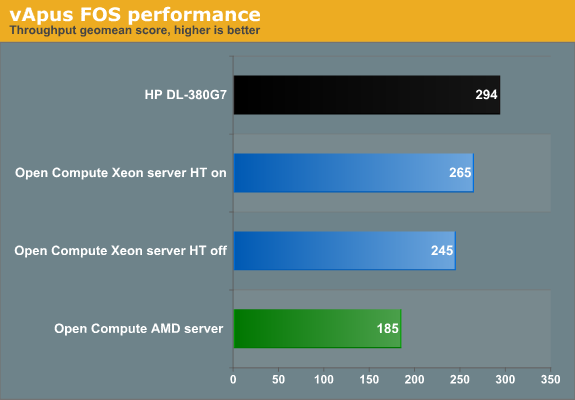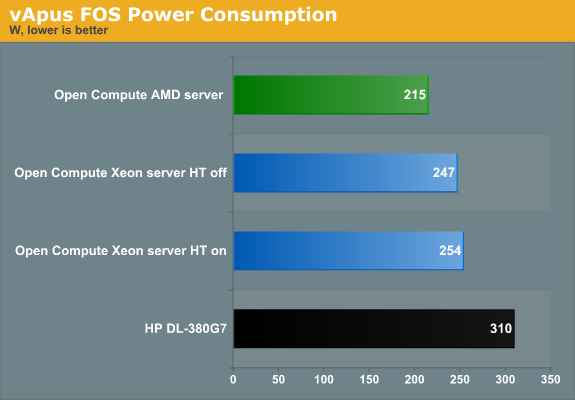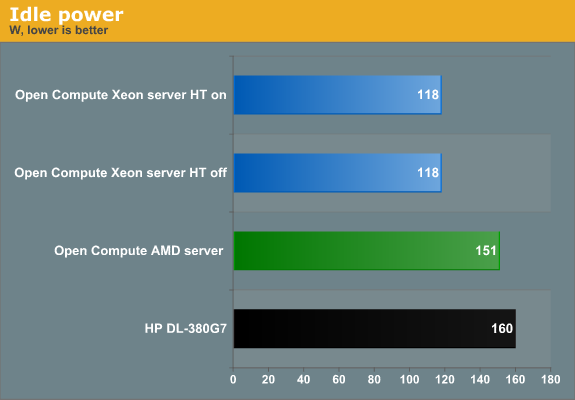Facebook's "Open Compute" Server tested
by Johan De Gelas on November 3, 2011 12:00 AM ESTvApus FOS results
In the first test, we use the vApus FOS test that pushes the servers to 90 - 100% CPU load. This performance test is not really important as these kind of server / application combinations are not supposed to run at these high CPU loads. Also remember that this is not an AMD versus Intel graph. The AMD based Open Compute server is used as a memcached server that typically hogs RAM space but does not stress the CPU; the Intel Open Compute Server is built to be a CPU intensive web application server. Thus, you should not compare them directly.
The real comparison is between the HP DL-380G7 and the Facebook Open Compute Xeon Server, which both use the same platform: the same CPUs, the same amount of RAM, and so on. The big question we want to answer is whether Facebook's server that is built specifically for low power use and cloud applications can offer a better performance/watt ratio than one of the best and most popular "general purpose" servers.

When requiring the highest performance levels, the HP DL380 G7 is about 11% faster than the Open Compute alternative. We suspect that the Open Compute server is configured to prefer certain lower power, lower performance ACPI settings. However, as this server is not meant to be an HPC server, this matters little. A web server or even virtualized server should not be run at 95-100% CPU load anyway. Let us take a look at the corresponding power consumption.

To deliver 11% higher performance, the HP server has to consume about 22% more power. The Open Compute servers deliver a higher performance/watt even at high performance levels. The advantage is small, but again these servers are not meant to operate at 95+ % CPU load.
We also checked the power consumption at idle.

The results are amazing: the Open Compute servers need only 74% of the power of the HP, saving a solid 42W when running ide. Also remember that the HP DL380 is already one of the best servers on the market from power consumption point of view.
Let us see what happens if we go for a real-world scenario.










67 Comments
View All Comments
JohanAnandtech - Thursday, November 3, 2011 - link
It is an ATI ES 1000, that is a server/thin client chip. That chip is only 2D. I can not find the power specs, but considering that the chip does not even need a heatsink, I think this chip consumes maybe 1W in idle.mczak - Thursday, November 3, 2011 - link
ES 1000 is almost the same as radeon 7000/ve (no that's not HD 7000...) (some time in the past you could even force 3d in linux with the open-source driver though it usually did not work). The chip also has dedicated ram chip (though only 16bit wide memory interface) and I'm not sure how good the powersaving methods of it are (probably not downclocking but supporting clock gating) - not sure if it fits into 1W at idle (but certainly shouldn't be much more).JohanAnandtech - Thursday, November 3, 2011 - link
I can not find any good tech resources on the chip, but I can imagine that AMD/ATI have shrunk the chip since it's appearance in 2005. If not, and the chip does consume quite a bit, it is a bit disappointing that server vendors still use it as the videochip is used very rarely. You don't need a videochip for RDP for example.mczak - Thursday, November 3, 2011 - link
I think the possibility of this chip being shrunk since 2005 is 0%. The other question is if it was shrunk from rv100 or if it's actually the same - even if it was shrunk it probably was a well mature process like 130nm in 2005 otherwise it's 180nm.At 130nm (estimated below 20 million transistors) the die size would be very small already and probably wouldn't get any smaller due to i/o anyway. Most of the power draw might be due to i/o too so shrink wouldn't help there neither. It is possible though it's really below 1W (when idle).
Taft12 - Thursday, November 3, 2011 - link
A shrink WOULD allow production of many more units on each wafer. Since almost every server shipped needs an ES1000 chip, demand is consistently on the order of millions per year.mczak - Thursday, November 3, 2011 - link
There's a limit how much i/o you can have for a given die size (actually the limiting factor is not area but circumference so making it rectangular sort of helps). i/o pads apparently don't shrink well hence if your chip has to have some size because you've got too many i/o pads a shrink will do nothing but make it more expensive (since smaller process nodes are generally more expensive per area).Being i/o bound is quite possible for some chips though I don't know if this one really is - it's got at least display outputs, 16bit memory interface, 32bit pci interface and the required power/ground pads at least.
In any case even at 180nm the chip should be below 40mm² already hence the die size cost is probably quite low compared to packaging, cost of memory etc.
Penti - Saturday, November 5, 2011 - link
It's the integrated BMC/ILO solution which also includes a GPU that would use more power then the ES1000 any how. That is also what is lacking in the simple Google / Facebook compute-node setup. They don't need that kind off management and can handle that a node goes offline.haplo602 - Thursday, November 3, 2011 - link
It seems to me that the HP server is doing as well as the Facebook ones. Considering it has more featuers (remote management, integrated graphics) and a "common" PSU.JohanAnandtech - Thursday, November 3, 2011 - link
The HP does well. However, if you don't need integrated graphics and you hardly use the BMC at all, you still end up with a server that wastes power on features you hardly use.twhittet - Thursday, November 3, 2011 - link
I would assume cost is also a major factor. Why pay for so many features you don't need? Manufacturing costs should be lower if they actually build these in bulk.